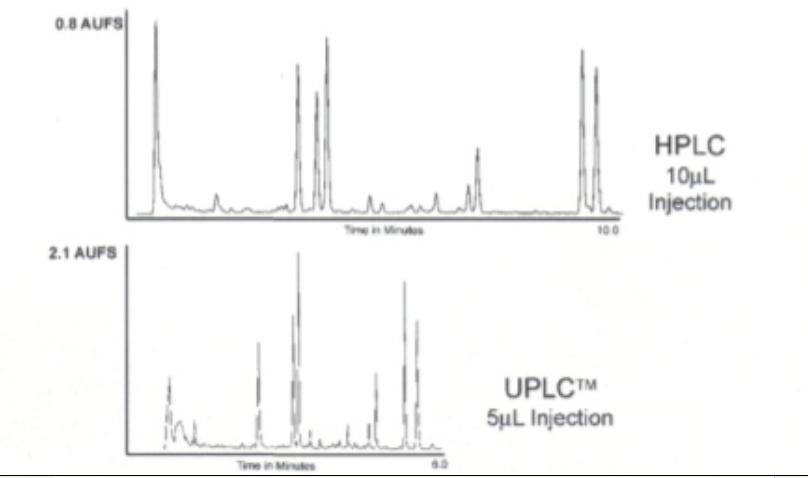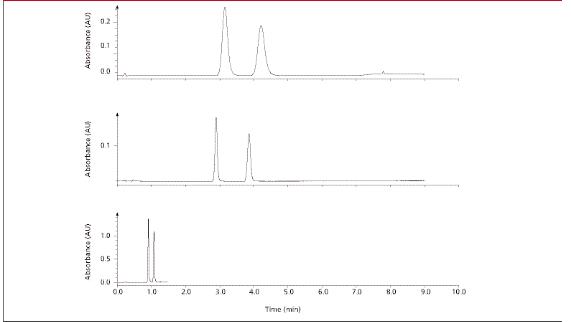شیمی تجزیه
شیمی تجزیه به عنوان یک بخش کاربردی در علوم مختلف است هدف از این وبلاگ ارائه روشهای تجزیه ای پرکاربرد است. https://www.instagram.com/_u/ShimiGeramشیمی تجزیه
شیمی تجزیه به عنوان یک بخش کاربردی در علوم مختلف است هدف از این وبلاگ ارائه روشهای تجزیه ای پرکاربرد است. https://www.instagram.com/_u/ShimiGeramNovel Achievement of HPLC: UPLC
معرفی کروماتوگرافی مایع در فشار بالا : UPLC
کروماتوگرافی مایع با کارایی بالا (HPLC) یک تکنیک شناخته شده است که بیش از 30 سال است در قریب به اتفاق آزمایشگاههای صنعتی مورد استفاده قرار می گیرد. عامل این دوام و موفقیت جداسازی ، اندازه گیری و شناسایی گونه ها در یک ترکیب پیچیده است. اصول علمی حاکم بر این امر با استفاده از معادله وان دیمتر توضیح داده می شود که وابستگی بین سرعت جریان خطی را با ارتفاع بشقابک تئوری (کارایی) بیان می کند.
مطابق این معادله با کاهش اندازه ذرات پرکننده کارایی افزایش می یابد و با افزایش سرعت خطی فاز متحرک یا فلو آن کارایی کاهش می یابد اما در اندازه ذره کمتر از 2/5 میلی متر نه تنها افزایش قابل توجهی در کارایی بوجود نمی آید بلکه کارایی با افزایش سرعت خطی یا فلو کاهش نمی یابد. با استفاده از ذرات کوچکتر سرعت و ظرفیت پیک (تعداد پیک ها در واحد زمان در جداسازی گرادیان) باعث توسعه روش مذکور به روش UPLC یعنی کروماتوگرافی مایع با کارایی فوق العاده (ultra performance liquid chromatography) می شود.
که UHPLC نیز خوانده می شود که مخفف عبارت
Chromatography Ultra High Performance Liquid می باشد.
بهتر است UPLC را کروماتوگرافی مایع در فشار بالا بنامیم یعنی:
Ultra High Pressure Liquid Chromatography
پمپ های متداول HPLC فشاری معادل 400 بار ( حدود psi 5800) تولید می کنند. در حالی که در UPLC پمپ توانایی ایجاد فشاری معادل 1000 بار ( حدود psi 14500) را دارد.
به این ترتیب با اندازه ذره کوچکتر از 2 میلی متر هنوز توانایی ایجاد جریان در حد بالاتر از 5 میلی لیتر در دقیقه وجود دارد.
استفاده از ذرات کوچکتر مزایای زیر را به دنبال دارد:
جداسازی (رزولوشن) بهتر = کارایی بیشتر یا کاهش زمان آنالیز یا هر دو مورد
بدست آوردن کروماتوگرام های باریک و مرتفع تر
شکل زیر نمایشی برای جداسازی از یک نمونه حقیقی به کمک تکنیک HPLC و UPLC است. به قد کشیدن و باریک شدن کروماتوگرام ها دقت کنید.

در این تکنیک با بهره گیری کامل از اصول کروماتوگرافی با استفاده از ذرات کوچکتر در ستون، با افزایش سرعت جریان فاز متحرک باعث کاهش زمان آنالیز شده و با افزایش کیفیت کروماتوگرام ها باعث افزایش حساسیت تکنیک شده است. همانطور که در شکل زیر ملاحظه میکنید در کروماتوگرام پایینی که با UPLC تحت شرایط بهینه بدست آمده زمان آنالیز کاهش یافته و پیک ها باریک تر شده اند.

METHOD OPTIMIZATION GUIDELINES AND OBSERVATIONS
During the course of optimizing the UPLC method, considerations to expedite future method transfers were developed, and the following recommendations were made:
Ø Increase elution solvent strength to reduce run times taking advantage of the high resolution potential of UPLC columns.
Ø Increase mobile phase flow rate secondarily to solvent strength in order to promote longer column lifetimes. While high mobile phase linear velocities with good resolution are possible, as with any column, routine operation at 80% maximum rated pressure led to shortened lifetimes. UPLC operation around 8000 psi or less provided comparable or lower column cost per assay than HPLC. Maintaining low flows as much as possible also reduces solvent and waste disposal costs, although these are already an order of magnitude less than HPLC.
Ø Reduce column re-equilibration times by taking advantage of the low system dwell volume. Programmed changes in the mobile phase take time to reach the column. The small UPLC dwell volume (measured as 110 µL, 15% of that of the HPLC) allowed in part the abbreviation of the original assay. Column re-equilibration accomplished during next sample loading in the UPLC, further increasing throughput.
Ø Reduce injection volumes appropriately for the column diameter to achieve good peak shapes. Peak splitting occur when too large of a strong sample solvent bolus overwhelms the packing at the column head. While this assay method tolerated 5 µL injections, volumes of 1–3µL are more typical starting points. Smaller injection volumes may be compensated by enhanced peak height from use of the high resolution columns and by the low carryover from the UPLC injector (measured as 10% of the HPLC carryover for this analyte) to achieve an equivalent or even lower LOQ). An alternative to smaller injection volumes might be to lower sample solvent strength to accomplish sample focusing on the head of the column.
Ø Utilize partial loop-fill injections in preference to full loop-fill. Partial loop-fill precision was good even at volumes up to 80% of the loop total volume . Typical laboratory practice is to limit sample volume injections to roughly 50% of the total loop volume. The UPLC injection system, which utilizes air-gap sandwiching of the sample, allows better utilization of the sample loop and higher injection precision, reducing the need for use of the full loop-fill mode. From a practical point of view, full loop fill requires substantially greater sample movement considering overfill functions. This likely increases subsequent needle washing, this may impact sample throughput and increase wear of the washing hardware. Larger sample volume transfers also increases exposure to sample particulates, lowering long-term instrument reliability.
Ø If full loop-fill mode is utilized, perhaps for very high precision requirements ensure adequate loop overfilling. A significant laminar flow velocity differential in the loading sample between its wall interface and center is created in the very narrow bore tubing of the UPLC injector. Overfilling the sample loop by at least four loop volumes was found necessary to fully displace wash solvent from the 5 µL injector loop. For this instrument, the manufacturer has determined and set as the default the optimum overfill volume with typical sample solvents for each sample loop size. Operators can specify other overfill volumes for unusual sample compositions.
Ø Choose the proper composition and volume of weak sample wash to obtain good peak shape. A portion of the weak sample wash solvent will be co-injected with partial-loop filled samples. The weak solvent wash should therefore mimic the initial conditions mobile phase in solvent strength. Utilizing the weak wash solvent as sample diluents in the sample loop may enhance sample focusing onto the column. The volume of the weak wash must be sufficient to purge the former strong wash solvent from the loop.
ADVANTAGES
ü Better resolution (separation efficiency)
ü Faster chromatography
ü Better sensitivity (sharper and higher peaks)
ü Less solvents
ü Withstand high back pressure system
DISADVANTAGES
ü Higher price of instruments, spare parts and columns
ü Also detector and data collection system (CDS) may not cope with sharper peaks (data acquisition rate).
ü So far only binary pump systems (not ternary or quaternary). This may make method transfer not straightforward.
ü Number of stationary phases still limited (improves quickly)
POTENTIAL AREAS OF USE
ü Analysis of complex mixtures (e.g. impurity profiles, formulation inerts)
ü At-line analysis in manufacturing (analysis at the vessel)
ü Analysis of large amounts of samples
ü For LC/MS to get better spectra (improved signal to noise)
APPLICATIONS
Ø With UPLC increased resolution in shorter run times can generate more information faster without sacrifices. Higher sample throughput with more information per sample may decrease the time to market, an important driving force in today’s pharmaceutical industry. The corresponding HPLC separation takes in excess of 12 min; UPLC accomplishes the same separation in under 30 s.
Ø UPLC can also be used to significantly improve the success of the drug discovery process. Drug discovery is heavily dependant upon the early prediction of metabolic fate and interactions of drug candidate molecules.
Ø Sensitivity, selectivity, and analysis time (sample throughput) are also some of the challenges analysts face when analyzing environmental samples such as soil and water. Explosives residues in soil or environmental waters are of both forensic and environmental interest. These types of assays prove challenging because of the selectivity needed to resolve positional isomers.
Ø In addition, for complex samples like natural product extracts, added resolution can provide more information in the form of additional peaks. HPLC versus UPLC separation comparison of a ginger root extract sample where both speed and resolution are improved. UPLC coupled with MS technology provided parent and fragment mass information of lipids in one chromatographic run, thus, providing an attractive alternative to current LC methods for targeted lipid analysis as well as lipidomic studies.
Ø Applications areas of UPLC specified in Waters literature include high throughput library screening, metabolite identification and bioanalysis, peptide mapping, stability indicating analyses, and quantitative analysis.
International Journal of PharmTech Research
Vol.3, No.3, pp1423-1429,
سلام ممنون از مطالبتون من دانشجوی ارشد شیمی تجزیه هستم من در مورد uplc وhplc سمینار دارم میشه ازتون خواهش کنم مقله یا مطلب به صورت فارسی به ایمیلم ارسال کنید ممنون از لطفتون
سلام
البته شما بهتر از امثال من می دانید که در دوره ارشد باید مهارت استفاده از متون انگلیسی و بویژه در مقالات تخصصی رو یاد بگیرید پس پیشنهاد میکنم همین سمینارو بهانه کنید برای این هدف بزرگ!
موفق باشید.
پی نوشت:
و اگر مقاله ای رو پیدا نکردین عنوانشو بنویسید تا ان شاءالله خیلی زود براتون بفرستم.
سلام
خیلی ممنونم استاد
یا علی
سلام
یا علی
سلام واقعا دلیلی نداشت جز وقت نکردن و اینکه اطلاعات این جانب در حد شما نیست... به قول استاد یمینی من رفته بودم که بیشتر آشنا بشم آخه همه اونایی که اونجا بودن دکتر،کارمندای شرکت هایی شیر و... بودن یا بچه های بیوتکنولوژی! بین اونا اول احساس کودک بودن بهم دست داد بعد امیدوار شدم که رفتم یاد بگیرم
واقعا دلیلی نداشت جز وقت نکردن و اینکه اطلاعات این جانب در حد شما نیست... به قول استاد یمینی من رفته بودم که بیشتر آشنا بشم آخه همه اونایی که اونجا بودن دکتر،کارمندای شرکت هایی شیر و... بودن یا بچه های بیوتکنولوژی! بین اونا اول احساس کودک بودن بهم دست داد بعد امیدوار شدم که رفتم یاد بگیرم
 ممنون یا علی
ممنون یا علی
استاد ببخشید،شما گفتید در مورد HPLC مطلب بذارم و من نذاشتم
وای چقدر حرف زدم
سلام
همه اون افرادی که به نظر شما بزرگ اومدن سواد عملیاتی شان کم بوده که نیازمند گذراندن دوره HPLC شده اند. در برخی از همان شرکتها افراد با سابقه کار زیادی وجود دارند که هنوز در فهم تئوری کروماتوگرافی مونده اند و نتوانسته اند با آن ارتباط برقرار کنند! به همین دلیل کوچکترین لذتی از کروماتوگرافی نمی برند و به محض گرفتن ستون و افزایش فشار سرستون به اندازه چند سال پیر می شوند و تنها راه حلی که به ذهنشان می رسد تعویض ستون است!
احساس کودک بودن شما را من به تشنه تر شدن تفسیر میکنم در دنیای علم جوجه نداریم همه بر حسب میزان انگیزش درونی شان تشنه یادگیری اند وقتی سن آدمی بالا می رود طبعا وقت آزادش برای یادگیری کم می شود. این احساس تشنگی در شما اگر حفظ شود حتما و قطعا باعث موفقیت شما در آینده ای نزدیک خواهد شد.
یک کروماتیست کارا هیچ وقت بیکار نخواهد ماند !!!
یا علی